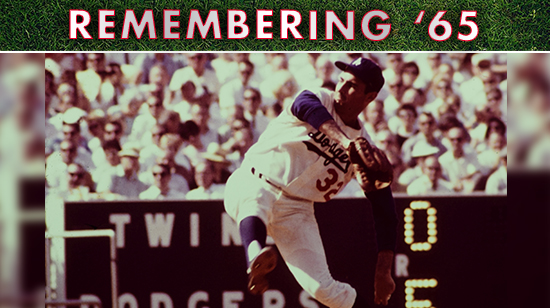By Jon Weisman
Pummeled mercilessly in Game 1 of the 1965 World Series, the Dodgers could console themselves by handing Game 2 to Sandy Koufax, who had just completed one of the most memorable seasons in baseball history — a 2.04 ERA, a perfect game and a big-league record 382 strikeouts.
Koufax had clinched the National League pennant for the Dodgers with a complete game on two days’ rest, capping a stretch in which he threw 27 innings in only eight days, allowing one run and striking out 38.
The brilliant lefty, whose entire season had seemed in jeopardy back in April, had logged 335 2/3 innings overall, the most by any Major Leaguer in more than a decade and the fourth-highest total since World War II. Seemingly, however, he had gone from brittle to indefatigable, and with a full four days’ rest heading into his Game 2 start, on October 7, 1965, confidence was high.
For five innings, pitching in a drizzle, 26-year-old Minnesota starter Jim Kaat and Koufax matched zeroes, with Koufax striking out eight of the first 18 Twins he faced. Kaat dodged a fifth-inning jam when, in between singles by Ron Fairly and Wes Parker, left fielder Bob Allison made a dazzling catch in the mud to rob Jim Lefebvre of extra bases.
[mlbvideo id=”20256157″ width=”550″ height=”308″ /]
“That could have turned the game around if Allison doesn’t get to that ball,” Dodger manager Walter Alston said, according to Times sports editor Paul Zimmerman.
Wrote Jim Murray in the Times about Allison’s catch: “That would have won him the water-polo championship of North America. He breast-stroked the last five feet.”
Instead, in the sixth inning, it was Koufax and the Dodgers who got dunked.
Zoilo Versalles began the bottom of the inning with a smash that handcuffed third baseman Jim Gilliam, rolling off him into left field for what Frank Finch of the Times called an “uncharitable” two-base error. One batter later, Versalles scored when Tony Oliva sliced a double to left, and Harmon Killebrew singled home Oliva for a 2-0 Twins lead.
The Dodgers rallied for their first run in the top of the seventh on singles by Fairly, Lefebvre and Johnny Roseboro, but that was all. Illustrating how the Dodger bench worked that year, Don Drysdale pinch-hit for Koufax with the tying and go-ahead runs in scoring position, but struck out, and Maury Wills flied out to strand them.
Versalles led the damage again in the bottom of the seventh with a two-out triple off Dodger relief ace Ron Perranoski, who then threw a wild pitch for a 3-1 Twins lead. In the eighth, Kaat put the cherry on his complete-game seven-hitter with a two-run single.
The three earned runs Perranoski allowed were more than he had surrendered in the last 47 2/3 innings of the regular season.
After the game, everyone wondered how it was possible that Koufax gave up all of two runs — some even questioning whether the four days off between starts had been too much for him. Like Drysdale in Game 1, Koufax said it was simply a matter of command.
“No, the cold weather didn’t bother me,” Koufax said. “I pitched and had good stuff on colder days. No, the park had nothing to do with it, nor the rain, nor the long layoff.
“I knew what I wanted to do out there but I just couldn’t do it. If I had had a little better control, or better stuff, I might have gotten away with it. … Kaat and Minnesota just did a better job. I was trying to get by with anything I had. If I could get somebody out by throwing my cap, I’d have done that, too.”
[mlbvideo id=”19972615″ width=”550″ height=”308″ /]
Kaat, who caught a line drive with two runners on in the ninth for the final out of the game, said he succeeded in part by ignoring the scouting report on the Dodgers.
“You start going too much into what guys can hit, and you can start trying to pitch too fine,” Kaat said, according to Times writer Charles Maher. “I felt if I looked at the scouting reports on the Dodgers, I’d just get myself more confused. If I can’t throw the ball over the plate, I’m not going to win anyway.”
As for the big catch in the fifth inning? “I didn’t think Allison had a prayer,” Kaat said.
The Dodgers would be heading back to Los Angeles needing to win four of their next five games, with their two leading pitchers already having been used once.
“We’ve been on both ends of this sort of thing,” Dodger manager Walter Alston said. “In 1955 we were down two games but came back to win the series. Then in 1956 against the Yankees we were ahead two games and lost it.
“I don’t think the pressure is going to bother this club because we’ve been under pressure all season long. This bunch will not quit on you. These fellows will battle back.”





oldbrooklynfan
During that time, I think, the Dodgers had a team that you can always count upon to to do whatever it took to win.